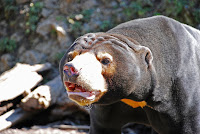Weirdest animals and creatures in the world
December 24, 2009
, Posted by Nunus at 6:15 PM
Sloths

Sloths come from one of the earliest mammalian orders, Xenarthra, and originated about 35 million years ago in the Late Eocene of South America. They are most closely related to armadillos and anteaters. Today, only two genera of sloths with five species exist in South America, whereas there used to be over thirty-five genera of the extinct ground sloths ranging from parts of Antarctica, South America, Central America, Hispaniola, and North America with some even going as far as Alaska.

Sakis, or saki monkeys are small monkeys with long, bushy tails. Their furry, rough skin is black, grey or reddish-brown colored depending upon the species. The faces of some species are naked, but their head is hooded with fur. Their bodies are adapted to life in the trees, with strong hind legs allowing them to make far jumps. Sakis reach a length of 30 to 50 cm, with a tail just as long, and weigh up to 2 kg.
Sun bear
The Sun Bear stands approximately 1.2 m (4 ft) in length, making it the smallest member in the bear family. It is often called the "dog bear" because of its small stature. It has a 5 cm (2 in) tail and usually weighs less than 65 kg (145 lb). Males tend to be slightly larger than females; the former normally weigh between 30 and 60 kg (66-132 lb), the latter between 20 and 40 kg (44-88 lb). The Sun Bear possesses sickle-shaped claws that are relatively light in weight. It has large paws with naked soles, probably to assist in climbing. Its inward-turned feet make the bear’s walk pigeon-toed, but it is an excellent climber. It has small, round ears and a stout snout.
Yeti Crab

Yeti Crab (Kiwa hirsuta) is a crustacean discovered in 2005 in the South Pacific Ocean. This decapod, which is approximately 15 cm long, is notable for the quantity of silky blond setae (resembling fur) covering its pereiopods (thoracic legs, including claws). Its discoverers dubbed it the "yeti lobster" or "yeti crab" .
Shoebill

Balaeniceps rex, also known as Whalehead, is a very large bird related to the storks. It derives its name from its massive shoe-shaped bill.
The Shoebill is a very large bird, averaging 1.2 metres tall, 5.6 kilograms and a 2.33 metres wingspan. The adult is mainly grey while the juveniles are browner. It lives in tropical east Africa in large swamps from Sudan to Zambia.
The Shoebill is a very large bird, averaging 1.2 metres tall, 5.6 kilograms and a 2.33 metres wingspan. The adult is mainly grey while the juveniles are browner. It lives in tropical east Africa in large swamps from Sudan to Zambia.
Pygmy Marmosets

Pygmy Marmosets are one of the smallest primates and they are the smallest monkey in the world. They have a body length between 12 and 15 cms, a tail length between 17 and 23 cms and they weigh between 100 and 125 g.
Pink Fairy Armadillo

The Pink Fairy Armadillo (Chlamyphorus truncatus) or Pichiciego is the smallest species of armadillo (mammals of the family Dasypodidae, mostly known for having a bony armor shell). It is approximately 90-115 mm long excluding the tail, and is pale rose or pink in color. It is found in central Argentina where it inhabits dry grasslands and sandy plains with thorn bushes and cacti. It has the ability to bury itself completely in a matter of seconds if frightened.
The Narwhal

The Narwhal (Monodon monoceros) is an Arctic species of cetacean. It is a creature rarely found south of latitude 70°N. It is one of two species of white whale in the Monodontidae family (the other is the beluga whale). It is possibly also related to the Irrawaddy dolphin.
Komodor

King of the Hungarian livestock guarding dogs, the Komondor, is one of the most unusual breeds. A big muscular dog covered with dense, white cords. This coat protects the dog against the elements and predators . The Komondor is a large dog with males standing at least 27 1/2" at the shoulders, while females must be at least 25 1/2" tall. Occasionally one may see a Komondor as large as 31" or even bigger, but these cases are rare. While large, the Komondor is not an overly heavy dog.
Hagfish

Hagfish are marine craniates of the class Myxini, also known as Hyperotreti. Despite their name, there is some debate about whether they are strictly fish (as there is for lampreys), since they belong to a much more primitive lineage than any other group that is commonly defined fish (Chondrichthyes and Osteichthyes). Their unusual feeding habits and slime-producing capabilities have led members of the scientific and popular media to dub the hagfish as the most "disgusting" of all sea creatures.
Frilled Lizard

The frilled lizard is obviously designed for climbing, it is a large slender species, two thirds of its body length are made up by its tail. It has a brightly coloured (often blue) frill which is most of the time folded against the neck, it may be extended at times of courtship or alarm. This is a relatively dull coloured lizard, a background of grey or brown with irregular darker marks.
Lives in Australia and Papua New Guinea. Eats Gutloaded insects (crickets, locusts, waxworms, morios, etc).
Lives in Australia and Papua New Guinea. Eats Gutloaded insects (crickets, locusts, waxworms, morios, etc).
The proboscis monkey
The proboscis monkey has one of the most unusual appearances of any of the leaf-eating monkeys of the family Cercopithecidae. Both the Latin and common names of this species refer to the mature males’ large pendulous nose that hangs down over their mouth. Local people referred to these large monkeys with their potbellies and red noses as ‘Dutch monkeys‘ as they were considered such a caricature of the Dutch sailors and plantation owners of the area
Red panda

The red panda, panda being the Nepalese name for "small, cat-like animal," belongs to the order Carnivora. Its classification into a specific order is not complete. Scientists are seeking to resolve the confusion through DNA analysis. Recent studies suggest that red pandas are equally related to three different groups of animals that include skunks, weasels and raccoons. The red panda is the only species in the subfamily Ailurinae.
Emperor Tamarin

The Emperor Tamarin (Saguinus imperator) is a tamarin allegedly named for its similarity with the German emperor Wilhelm II. The name was first intended as a joke, but has become the official scientific name.
This tamarin lives in the southwest Amazon Basin, in east Peru, north Bolivia and in the west Brazilian states of Acre and Amazonas.
This tamarin lives in the southwest Amazon Basin, in east Peru, north Bolivia and in the west Brazilian states of Acre and Amazonas.

Scientists were conducting fieldwork in the fast-disappearing forests of Madagascar when they found this new species of bat with sticky suckers on its feet and thumbs.
The creature, dubbed Myzopoda schliemanni, uses the adhesive organs to scale the large, broad leaves of tropical plants where it roosts.
The creature, dubbed Myzopoda schliemanni, uses the adhesive organs to scale the large, broad leaves of tropical plants where it roosts.
The Aye-aye

The Aye-aye (Daubentonia madagascariensis) is a strepsirrhine native to Madagascar that combines rodent-like teeth with a long, thin middle finger to fill the same ecological niche as a woodpecker. It is the world’s largest nocturnal primate, and is characterized by its unique method of finding food; it taps on trees to find grubs, then gnaws holes in the wood and inserts its elongated middle finger to pull the grubs out.
Tapir

Tapirs are large browsing mammals, roughly pig-like in shape, with short, prehensile snouts. They inhabit jungle and forest regions of South America, Central America, and Southeast Asia. All four species of tapir are classified as endangered or vulnerable. Their closest relatives are the other odd-toed ungulates, horses and rhinoceroses.
The Philippine Tarsier

The Philippine tarsier, (Tarsius syrichta) is very peculiar small animal. In fact it is one of the smallest known primates, no larger than a adult men’s hand. Mostly active at night, it lives on a diet of insects. Folk traditions sometimes has it that tarsiers eat charcoal, but actually they retrieve the insects from (sometimes burned) wood. It can be found in the islands of Samar, Leyte, Bohol, and Mindanao in the Philippines.
Alpaca

The Alpaca (Vicugna pacos) is a domesticated species of South American camelid. It resembles a small llama in superficial appearance.
Alpacas are kept in herds that graze on the level heights of the Andes of Ecuador, southern Peru, northern Bolivia, and northern Chile at an altitude of 3500 to 5000 meters above sea-level, throughout the year.
Alpacas are kept in herds that graze on the level heights of the Andes of Ecuador, southern Peru, northern Bolivia, and northern Chile at an altitude of 3500 to 5000 meters above sea-level, throughout the year.
Axolotl

The Axolotl may not a common pet, but it is very unique. The axolotl is a type of salamander, native to Mexico. It’s scientific name is Ambystoma mexicanum. The common pet or laboratory Axolotl refers exclusively to A. mexicanum, although in Mexico the term Axolotl is used in reference to several species of Ambystoma, and is considered an edible food source!
Anggora Rabbit

The Angora rabbit is a variety of domestic rabbit bred for its long, soft hair. The Angora is one of the oldest types of domestic rabbit, originating in Ankara, Turkey, along with the Angora cat and Angora goat. The rabbits were popular pets with French royalty in the mid 1700s, and spread to other parts of Europe by the end of the century. They first appeared in the United States in the early 1900s. They are bred largely for their long wool, which may be removed by shearing or plucking (gently pulling loose wool).
Dumbo Octopus

Also known as the "Grimpoteuthis", is a benthic mollusc found on the ocean floor at depths of 300-400 meters. Dumbo octopuses, which can grow to up to 20 centimeters, are soft-bodied or semi- gelatinous octopuses with a pair of fins located on their mantle and webbing between their arms. Grimpoteuthis swim by moving their fins, pulsing their webbed arms, pushing water through their funnel for jet propulsion, or all three at once. They can swim up off the bottom and hover a bit just above the seafloor looking for snails, worms, and other food.
Blobfish
The blobfish (Fathead, Psychrolutes marcidus) is a fish that inhabits the deep waters off the coasts of Australia and Tasmania. Due to the inaccessibility of its habitat, it is rarely seen by humans.











Currently have 0 Comments: